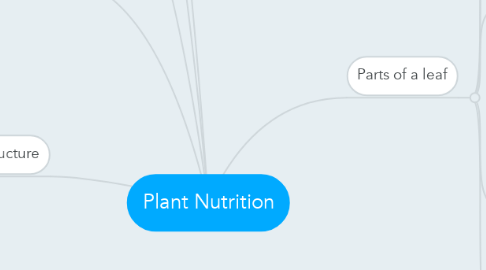
1. Internal Structure
1.1. Mesophyll
1.1.1. Site of photosynthesis (Both)
1.1.2. Palisade mesophyll tissue
1.1.2.1. Long cells have many chloroplasts
1.1.3. Spongy mesophyll tissue
1.1.3.1. Cells irregularly shaped
1.1.3.2. Intercellular air spaces
1.1.3.3. Chloroplasts
1.2. Chloroplasts
1.2.1. Internal Structure
1.2.1.1. Granum
1.2.1.1.1. Stacks of thylakoids
1.2.1.2. Chloroplast envelope
1.2.1.3. Stroma ( Similar to Cytoplasm)
1.2.1.3.1. Site for light-independent reactions
1.2.1.3.2. Enzymes for light-independent reactions
1.2.1.4. Starch grain ( Manufactured by chloroplast)
1.3. Epidermis
1.3.1. Upper and Lower
1.3.1.1. Keep the Leaf's shape
1.3.2. Cuticle (Upper layer )
1.3.2.1. Reduce Evaporation
1.3.2.2. Reduce water loss (Waxy layer)
1.3.2.3. Focuses the light on mesophyll layers (Upper)
2. Entry of CO2 into the leaf
2.1. Co2 is used in photosynthesis
2.1.1. Diffusion of CO2 through stomata into intercellular air spaces
2.1.1.1. Dissolves in thin film of water on mesophyll
2.1.1.1.1. Then diffuses into the cells
3. Photosynthesis
3.1. Light dependent
3.1.1. Light energy absorbed by chlorophyll converted to chemical energy
3.1.1.1. Chemical Energy: Adenosine Triphosphate + Reduced nicotinamide dinocleotide phosphate
3.1.1.1.1. Light energy -------> Chemical Energy (ATP+NADPH)
3.1.2. Light energy splits water molecules to oxygen+ hydrogen (Photolysis)
3.1.2.1. Water ---------> Oxygen+ Hydrogen
3.1.2.1.1. 12H20------> 6O2 + 24H
3.1.2.2. Hydrogen used to create ATP
3.1.3. Happens concurrently
3.2. Definition
3.2.1. Light energy absorbed by chlorophyll
3.2.1.1. Is transformed into chemical energy
3.2.1.1.1. used to synthesize carbohydrates from water and carbon dioxide
3.3. Light independent
3.3.1. Hydrogen reduces CO2 to carbohydrates (glucose)
3.3.1.1. Requires chemical energy
3.3.1.1.1. Carbon Dioxide + Hydrogen ---------> Glucose + Water
3.4. Overall Equation
3.4.1. Carbon Dioxide + Water ---------> (Chlorophyll, light) Glucose + Oxygen
3.4.1.1. 6CO2 + 6H2O ------------> (Chlorophyll, light) C6H12O6 + 6O2
3.5. Absorption Spectrum and Action Spectrum
3.5.1. Absorption spectrum
3.5.1.1. Graph of the amount of light absorbed of different wavelengths of light by a photosynthetic pigment
3.5.2. Action spectrun
3.5.2.1. Graph of the effectiveness of relative photosynthetic rates during photosynthesis at different wavelengths of light
3.5.3. Violet blue and Red light absorbed most by chlorophyll and most effective wavelength for photosynthesis
4. Limiting Factors
4.1. Concentration of Carbon Dioxide
4.1.1. Normally most major limiting factor
4.2. Light Intensity
4.3. Temperature
5. Fates of Glucose
5.1. Tissue Respiration
5.1.1. Energy
5.2. Make cellulose cell walls
5.3. Converted to sucrose
5.3.1. Stored as starch or other forms in storage organs
5.3.1.1. Reconverted by enzymes to simple sugars
5.3.2. If too large amount, stored as starch in leaves
5.4. Reacts with nitrates and other mineral salts to form amino acids
5.4.1. Combine to form proteins
5.4.2. Excess amino acids stored as proteins to build new protoplasm
5.5. Fats are formed
6. Parts of a leaf
6.1. Lamina (Leaf blade)
6.1.1. Large, flat surface
6.1.1.1. Maximise exposure to sunlight
6.1.2. Thin
6.1.2.1. Allow CO2 to reach inner cells rapidly
6.1.2.2. Allow sunlight to reach all mesophyll cells
6.2. Petiole (Leaf Stalk)
6.2.1. Hold lamina away from stem
6.2.1.1. Absorb maximum sunlight
6.3. Veins
6.3.1. Carry water and dissolved mineral salts
6.3.1.1. Diffuse from cell to cell to mesophyll cells
6.3.2. Carry manufactured food
6.3.3. Monocot - Parallel
6.3.4. Dicot - Branches
6.4. Stomata
6.4.1. Abundant in lower epidermis
6.4.2. Control pore opening and closing so water cannot escape
6.4.3. Pair of guard cells surrounding stomatal pore
6.4.3.1. Guard Cells contain chloroplasts (Only epidermal cells with chloroplasts )
6.4.3.1.1. Photosynthesis during sunlight hours
6.4.3.2. Guard cells have a thicker cellulose wall on side of stomatal pore
6.4.3.2.1. Part of cell wall less able to stretch
6.4.3.2.2. Causes guard cell to curve
6.4.3.3. Sugar is used up at night
6.4.3.3.1. Water potential up
6.5. Without magnesium, leave will turn orange-red
6.5.1. xanthophyll but chlorophyll not produced

